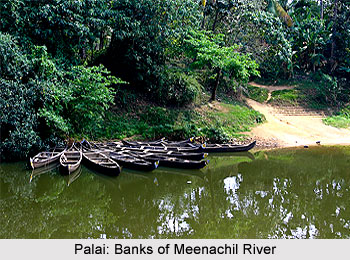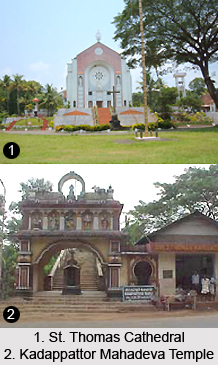Palai, also known as Pala, is a municipal town located in Kottayam district in the state of Kerala. The town covers a total area of 15.93 sq km and the nearest cities are Muvattupuzha and Kottayam. The name Palai is derived from Palazhi or Ksheera Sagara, which according to mythology is the Ocean of milk from where nectar was obtained. It is also believed that the name of the municipal town is based on the names of the Palathu Chettiyar family who were the earliest settlers in the region. Palai consists of the major proportion of Syrian Malabar Nasrani community, which is in Kerala. The town is located around 32 km towards the east of Kottayam and 173 km North from Thiruvananthapuram, the capital of the state. It is situated on the Meenachil River banks and is also the headquarters of the Pala Revenue Division and the Meenachil Taluk. Palai is amongst the most important entrances to the southern high ranges of Western Ghats.
History of Palai
The earliest settlements in the Palai region can be traced back to 1000 AD. Palai was included in the former princely state of Travancore which was ruled by the Kings of Travancore. Meenachil Karthas were the chiefs of the local clans. Njavakattu Karthas were the first royal Kartha families and they had the title of Damodara Simhar. The Njavakattu Karthas were the rulers of the kingdom of Meenachil, which is presently known as Palai in the district of Kottayam. Their family deity was called Simhar (Bhavai) and Mevada (Mewar) was the family name. They were followers of Marumakkathayam and were pure vegetarians. The clan had no Poonul (sacred threads) and conducted multihued funeral processions. The Njavakattu Karthas ruled Meenachil taluk and helped in promotion of the Christian settlement in the region. The Christian settlers were nainly occupied in trade and agriculture. It is believed that Palai market was founded by Christian settlers in 1736 on the banks of Meenachil River.
 Travancore army of Dharma Raja, the successor of Marthanda Varma, defeated them and the kingdom was annexed to Travancore. The male population, including young boys, was slaughtered and the women were spared. The family had a successor only after a long hiatus due to this genocide by the Travancore forces.
Travancore army of Dharma Raja, the successor of Marthanda Varma, defeated them and the kingdom was annexed to Travancore. The male population, including young boys, was slaughtered and the women were spared. The family had a successor only after a long hiatus due to this genocide by the Travancore forces.
Geography of Palai
The geographical co-ordinates of Palai is 9.7 degree N 76.7 degree E. the municipal town is located 56.7 m above mean sea level and the total area is spread over 15.93 sq km. there are several other towns that are located nearby, such as Ponkunnam, Kottayam, Muvattupuzha, Erattupetta and Thodupuzha. Palai is situated on the Main Eastern Highway that is the Punalur Road-Pathanamthitta-Muvattupuzha (SH-08). The state highway SH-32, which runs from Poonjar to Ettumanoor, also runs through Palai.
Some of the other nearby towns are Ettumanoor, Changanassery, Kanjirappally, Vaikom, Kothamangalam, Poonjar, Tiruvalla. Nearby cities include Thrissur (121 km north), Kozhikode (240 km Northwest), Thiruvananthapuram (173 km south), Kochi (78 km northwest), Kollam (120 km Southwest), Madurai (223 km Northeast) and Coimbatore (235 km Northeast).
Demography of Palai
According to the 2001 India Census, the population of Palai is 22,640 and the men constitute 49% of the total population and women 51%. The average literacy rate of the town is 98%, which is higher than the national average of 73%. The higher than the national average of 73% of males is 98.5% and female literacy is 97.8%. In Palai, 10% of the population is below 6 years of age.
Culture of Palai
Even with a diverse population, Palai is a significant hub of Roman Catholic Syrian Christians in India. The people of the region are regarded as hard workers, as most of the population migrated from Meenachil Taluk to the Malabar region of Kerala and the high ranges. They converted the forest land into cultivated lands and farms.
Education of Palai
There are several Colleges in Palai that are affiliated to the Mahatma Gandhi University in Kottayam. Educational institutes in the region are centres of sports excellence. Popular sports persons like volleyball player Jimmy George and Olympian Shiny Wilson completed their education from Palai. Many institutions are operated under the management of the Diocese of Pala.
Some of the esteemed schools and colleges in the region include St. Augustine`s HSS, Ramapuram (Kerala Board), Chavara CMI International School, Ramapuram (ICSE and ISC), St. Mary`s HSS, Palai (Kerala Board), Alphonsa Residential School Bharanganam (ICSE), St. J.N.HSS, Kozhuvanal (Kerala Board), St. Thomas College, Palai, Alphonsa College, Palai, St. Joseph`s College of Engineering and Technology, Palai, Co-operative Engineering College, Kidnangoor, Mangalam college of Engineering, Ettumanoor, St. Antony`s HSS, Plassanal (Kerala Board), Labour India Gurukulam public school, St. Thomas Teacher Training College, Palai, Cherian Kappen memorial ITI etc.
 Tourism of Palai
Tourism of Palai
Palai is one of the popular religious destinations in the state of Kerala. Pala Diocese was constructed in the year 1950 and is much venerated by the Syrian Christians of Pala. Few churches have also been established in the earlier centuries. The Lalam Old Church (St Mary`s Church) was constructed in 1663. St. Thomas Cathedral and St. Mary`s Church, Lalam are two of the major Christian churches in Palai. The shrine of Kurishupalli acts as a landmark and is situated at the centre of the Palai town. Palai has several other ancient churches that are regarded as pilgrim centers.
Other than the various churches, there are 11 temples in Palai and Lalam Mahadeva Temple is the most popular temple and is also known as Dakshina Kasi. The temple is located on the bank of Lalam River, at the centre of Palai. The most famous Hindu temple is Kadappattor Mahadeva Temple, located on the bank of Meenachil River. Numerous pilgrims visit the temple through out the year.
Other renowned temples in Palai are Chembittambalam Kizhathadiyoor Thrukkayil Mahadeva Temple, Kizhathadiyoor Puthiyakavu Devi Temple, Vellappattu Sree Vana Durga Bhagavathy Temple, Murikkumpuzha Devi Temple, Anakkulangara Bhagavathy Temple, Ooraasala Subrahmanya Swami Temple, Idayattu Bala Ganapathy Temple, Kochidappady Sree Shanmugha swami Temple, Narasimha Swami Temple and Thattarakathu Bhagavathy Temple.






